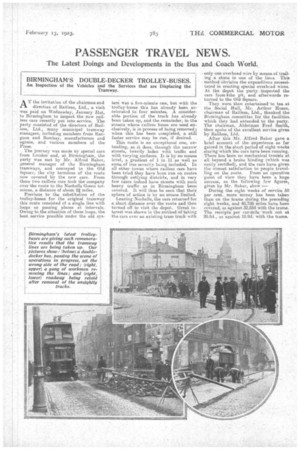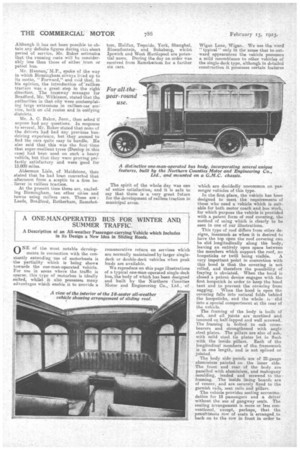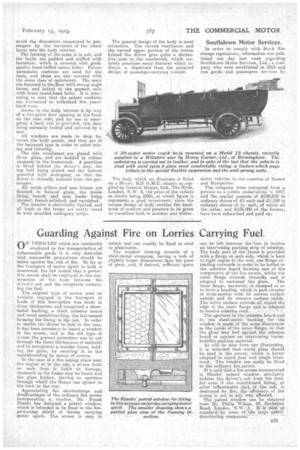PASSENGER TRAVEL NEWS.
Page 15

Page 16

Page 17

If you've noticed an error in this article please click here to report it so we can fix it.
The Latest Doings and Developments in the Bus and Coach World..
BIRMINGHAM'S DOUBLE-DECKER TROLLEY-BUSES.
An Inspection of the Vehicles and the Services that are Displacing the Tramway.
AT the invitation of the chairman and directors of Raille.ss, Ltd., a. visit was paid on Wednesday, January 31st, to Birmingham to inspect the new rail, less cars recently put into service. The party consisted of the directors of Railless, Ltd., many municipal tramway managers, including members from Rangoon and Bombay, manufacturers and agents, and various members of the Press.
The journey was made by special cars from London and, at Birmingham, the party was met by Mr. Alfred Baker, general manager of the Birmingham tramways, and conveyed to the Old Square, the city terminus of the route now covered by the new cars. From there two railless cars took the company over the route to the Nechells Green terminus, a distance of about 2i miles.
Previous to the substitution of the trolley-buses for the original tramway this route consisted of a single line with loops or passing places at intervals. Owing to. the situation of these loops, the best service possible under the old sys tern was a five-minute one, but with the trolley-buses this has already been accelerated to four minutes. A considerable portion of the track has already been taken up, and the remainder, in the Streets where railless buses are used exclusively. is in process of being removed; when tills has been completed, a still faster service may be run, if desired.
This route is an exceptional one, extending, as it does, thiough the narrow streets, heavily ,laden with traffic and with varying surfaces. It is by 130 means level, a gradient of 1 in 11 as well as some of less severity being included. In all other towns where railless cars have been tried they have been run on routes through outlying districts, and in very few cases indeed have streets with such heavy traffic as in Birmingham been revered. It will thus be seen that their sphere of action is by no, means limited..
Leaving Nechells, the cars returned for a short distance over the route and then turned off to visit the depot. Great interest was shown in the method of taking the cars over an existing tram track with
• only one overhead wire by means of trailing a skate in one of the lines. This method obviates the expenditure necessitated in erecting special overhcad wires. At the depot the party inspected the cars from the pit, and afterwards returned to the Old-Square.
They were then entertained -to tea, at the Social Hall, Mr. Arthur Hoare, chairman of 'tailless, Ltd., thanked the Birmingham committee for the facilities which they had extended to the party. The chairman, Alderman Fred Smith, then spoke of the excellent service given by Raiiless, Ltd. After this Mr. Alfred Baker gave a brief account, of the experience so far gained in the short period of eight weeks during which the cars have been running. There has been no mechanical trouble at all beyond a brake binding (which was easily rectified), and the cars have given the utmost satisfaction to people travelling on the route. From an operative point of view they have been a. huge success, as the following few figures, given by Mr. Baker, show:— During the eight weeks of service 60 per cent, more money has been taken than on the trams during the preceding eight weeks, and 48,726 miles have been covered, as against 32,854 with the trams. The receipts per rar:mile work out at 20.5(1., as against 18.9cl. with.the trains.
Although it has not been possible to obtain any definite figures during this short period of service, Mr. Baker estimates that the running costs will be considerably less than those of either tram or petrol bus.
Mr. Hannon, Mr., spoke of the way in which Birmingham. always liVed up to its motto, " Forward,". and said that, in his opinion, the introduction of -runless traction was a great step in the right direction. . The tramway manager for Bradford, Mr. Wilkinson, stated that the authorities in that city were contemplating large extensions in minces-cm service, both on old routes and in outlying districts.
Mr. A. C. Baker, Junta, then asked if anyone had any questions. In response to several, Mr. Baker stated that none of the drivers had had dny previous busdriving experience, but they seemed to find the cars quite easy to handle. He also said that this was the first 'time that super-resilient tyres (Dunlop in this case) had been used on such a heavy vehicle, but that they were proving perfectly satisfactory and were good for 15;000 miles.
Alderman Lisle, of Maidstone, then stated that he had been converted that afternoon from a sceptic to a firm believer in railless traction.
At the present time there are, excluding Birmingham, ten other cities and towns using railless ears. These are : Leeds, Bradford, Rotherham, Ramsbot
torn, Halifax, Teesside, York, Shanghai, Bloemfontein, and Boksburg, whilst Ipswich and West Hartlepool are potential users. During the day an order was received from Rarosbottom for a further six cars.
The spirit of the whole day was one of entire satisfaction, and it is safe to say that there is a very great future for the development of railless traction in municipal areas.
A ONE-MAN-OPERATED BUS FOR WINTER AN SUMMER TRAFFIC.
A Description of an All-weather Passenger-carrying Vehicle which Includes in its Design a New Idea in Sliding Roofs.
0 NE of the most notable developments in connection with the constantly extending use of motorbuses is the partiality which is being showa towards the one-man-operated vehicle. For use in areas where the traffic is sparse. this type of motorbus ia ideally suited, whilst it also possesses many advantages which enable it to provide a
remunerative return on services which are normally maintained by larger singledeck or double-deck vehicles when peak loads are available.
We reproduce on this page inuatrationa of a typical one-man-operated single-deck bus' the body of which has been designed and built by the Northern Counties Motor and Engineering Co., Ltd,, of
Wigan Lane, Wigan.: We use the word " typical " only in the sense that to outward appearances the vehicle possesses a mild resemblance to other vehicles of the single-deck type, although in detailed construction it possesses certain features which are decidedly uncommon on passenger vehicles of this type.
In the first place, the vehicle has been designed to meet the requirements of those who need a vehicle which is suit able for both motor coach and bus work, for which purpose the vehicle is provided with a patent form of roof covering, the method of using which is clearly to be seen in one of our illustrations.
This type of roof differs from other designs, inasmuch as when it is desired to have the top open the roof covering can be slid longitudinally along the body; leaving an entirely open space between the members which support the roof, no hoopsticks or twill being visible. A.
very important point in connection with this hood is that the covering is not rolled, and therefore the possibility of fraying is obviated. When the hood is closed a patent device engages with the first hoopstick in order to keep the hood taut and to prevent the covering from sagging. When the hood is open the covering falls into natural folds behind the hoopsticks, and the whole is slid into a special compartment at the rear of the vehicle.
The framing of the body is built of ash, and all joints are mortised and
tenoned oa half-lapped and well screwed.
The framing is bolted to oak crossbearers and strengthened with angle steel plates. The pillars are also of ash, with mild steel tie plates let in flush with the inside pillars. Each of the longitudinal members of the framework is in one length, and is not spliced or jointed.
The body side panels are of 22-gauge aluminium painted on the inner side.
The front and rear of the body are panelled with aluminium, and mahogany moulding, leaded and screwed to the , framing. The inside lining boards are of veneer, and are securely fixed to the garnish rails seat rails and pillars.
The vehicle provides seating accommodation for 18 passengers and a driver without the use of gangway seats. The seating arrangement is more or less conventional, except, perhaps, that the _ penultimate row of seats is arranged_to back on to the row in front in order to
avoid the discomfort occasioned to passengers by the intrusion of the wheel boxes into the body interior.
' The framing of the seats is in ash, and the backs are padded and stnfied. with horsehair, which is covered with good. quality hand-huffed motor hides. Patent pneumatic cushions are used for the seats, and these are also covered with the same class of upholstery. The seats are fastened to the floor with strong angle knees, and bolted to the garnish rails with brass round-head bolts. It is interesting to note that the patent cushions are warranted to withstand five years' hard wear.
Aces to the body interior is by way of a two-piece door opening at thefront on the near side, and for use in emergency a back exit is-provided, this door being normally locked and cOVered by a„
seat. . • All windows are made to drop betiveen the body panels, and they are of the balanced type in order to assist 'rajaing and lowering.
The side ventilators are glazed with 26-oz. glass, and are bedded in rubber channels in the framework. A partition is fitted behind the driver's seat, the top half being glazed and -the bottom panelled wi,th mahogany, so that the driver is virtually isolated from the passengers.
All inside pillars and seat frames are finished in hatural grain, the inside lining boards and seat backs being stained, french-polished, and varnished. The interior is electrically lighted, and all leads to the lamps are neatly cased in with moulded mahogany strips.
The general design of the body is most attractive. The curved ventilators arid the curved upper portion of the screen behind the driver give quite a distinctrveenete to.the coachwork; -which certainly possesses many features which indicate a departure from the accepted design of passenger-carrying vehicle.
The body which we illustrate is fitted on a 30-cwt. K16 G.M.C. chassis as supplied by General Motors, Ltd., The Hyde, London, N.W. 9, the price of the vehicle as shown being £660, at which figure it represents a good investment, since the unique design of body enables the maximum of comfort and pleasure to be given to travellers both in summer and :sinter.
In order to comply with Stock Exchange regulations, information was published one day last week regarding Southdown Motor Services, Ltd., a company who were established in 1915 and run goods and passengers services by
motor vehicles in the counties of Sussex and Hampahipe:
The company were converted from a private to a public Undertaking in 1917, and the capital consists of £150,000 in ordinary shares of £1 each and £1,250 in ordinary shares of is. each, of Which all the latter, and £125,000 of the former, have been subscribed and paid up.
































